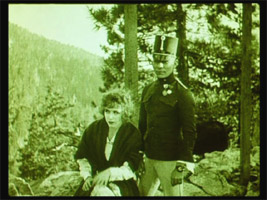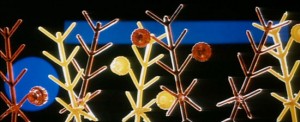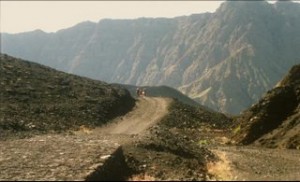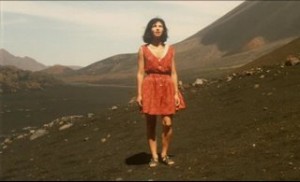From DVD Beaver, posted in November 2008. Some of the links may be out of date by now. — J.R.
The following selection is not only personal but very eclectic. It’s not exactly a list of my favorite films: I prefer Erich von Stroheim’s Foolish Wives (1922) and Greed (1924) to his Blind Husbands (1919), for instance, and if I had to take one Anthony Mann film along with me to a desert island, this would undoubtedly be The Naked Spur (1953) rather than his Man of the West (1958). Similarly, my favorite films by Nicholas Ray are probably Johnny Guitar (1954) and Bitter Victory (1957), even though Party Girl (1958), for all its flaws, is still a Ray film that I’d describe as sublime. But I’ve opted in these cases for the DVDs devoted to Stroheim, Mann, and Ray that I cherish the most, and the reasons why I cherish them are stated below.
A few other caveats:
(a) There are at least two other editions of Carl Dreyer’s Gertrud (1964) —- the U.S. one from Criterion and the English one from the British Film Institute—- that are top-notch, and they’re probably easier to come by in the Western hemisphere than the Australian edition on the Madman label that I cite. But it’s only the Australian edition that has Adrian Martin’s wonderfully penetrating and thoughtful commentary, which is why I’ve opted for including that one.
(b) I’ve aimed overall for a certain geographical spread, with the result that releases from Australia, Austria, China, England, France, Italy, and Portugal (and films from Austria, China, Denmark, France, India, Iran, Portugal, and the U.S.) are included. But I hasten to add that the fact that two of these releases come from Austria, two from Portugal (both of which are by the same filmmaker, Pedro Costa), and three from France doesn’t mean that I’m ranking these countries overall as purveyors of DVDs over any others — nor am I necessarily ranking Costa over all other Portuguese filmmakers. I may also be technically cheating a little by including one all-region or region-free DVD, Tian Zhuangzhuang’s The Horse Thief (1986, from mainland China), on my list.
(c) I’ve made room for three collections of short films as well as ten features (one of these DVDs, devoted to Andy Warhol, carries two short features).
(d) One of the French releases — Un feu + La maison est noire, two Iranian short films included as part of a now-defunct French film magazine — isn’t outfitted with English subtitles, unlike the five DVDs I’ve included that don’t have English-speaking features, which are. I’ve also included one French film (Où gît votre sourire enfoui?) that’s on a Portuguese DVD, Onde Jaz O Teu Sorriso?, which is boxed along with a book bearing the same Portuguese title; everything on this DVD is provided with English subtitles, but nothing in the book is translated into any other language. But even though I can’t read the book, this is still one of my favorite DVDs.
(e) The order of the following dozen DVDs is chronological–according to when the film (or earliest film, when more than one is included) was made, not when the DVD was released.
(NOTE: CLICK ON TITLES, COVERS OR UNDERLINED TEXT FOR LINKS)
| Available from the Edition Filmmuseum HERE | 1) Blind Husbands (Erich von Stroheim, 1919). When, a little over a quarter of a century ago, I organized a retrospective of the films of Jean-Marie Straub and the late Danièle Huillet at New York’s Public Theater, I invited this couple to select over a dozen films by other filmmakers to be shown with theirs. Blind Husbands was the feature of Stroheim, one of their favorite directors, that they unexpectedly selected. When I asked why they settled on his relatively obscure first feature rather than Foolish Wives or Greed or The Merry Widow or The Wedding March or Queen Kelly, their answer was both simple and in retrospect, obvious: Blind Husbands was the only feature of Stroheim’s on which he had relatively complete and absolute control over the final editing. It also provides a kind of template of all of Stroheim’s subsequent features. Starring, in his first major role, as Lieutenant Erich von Steuben — a unscrupulous and dishonest womanizer (Francelia Billington) bent on seducing a married woman while she’s vacationing with her surgeon husband (Sam De Grasse) in Tyrol, a mountainous region of western Austria —- he offers a vivid, caustic, witty, and ironic self-portrait as “the man you love to hate,” as Stroheim the actor was described in the ads. (It wasn’t until shortly after his death that Stroheim himself became publicly unveiled as the sort of imposter he often played —- a Jew from Vienna with none of the aristocratic background he pretended to have, who’d added “von” to his own name.) And he also virtually launches in this movie the Hollywood trend of associating naughty sex with Continental Europe that later directors such as Ernst Lubitsch and Josef von Sternberg would also adopt and build upon. |
| Part of what’s so special about this particular 2006 release is that it derives from the 1982 rediscovery by the Austrian Film Archives of an Austrian version of the film seven minutes longer than existing Hollywood prints, with somewhat different editing, making it both the oldest and most complete version that we have. A scholarly edition of one of the most entertaining Hollywood features of the late teens, it comes with an effective musical score, a bilingual and illustrated 20-page booklet, and many other features. | |
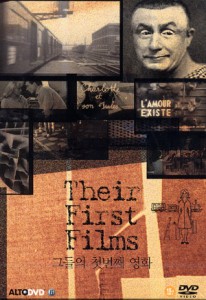 |
|
| 2) Their First Films (24 Heures de la vie d’un Clown, Jean-Pierre Melville, 1946; Le Chant du styrène, Alain Resnais, 1957; Le coup de berger, Jacques Rivette, 1957; Les surmenés, Jacques Doniol-Valcroze, 1957; Charlotte et son Jules, Jean-Luc Godard, 1958; Histoire d’eau, Francois Truffaut & Jean-Luc Godard, 1958; L’amour existe, Maurice Pialat, 1961; Le Laboratoire de l’angoisse (Patrice Leconte, 1971). Believe it or not, this user-friendly and beautifully designed collection of eight rare French shorts–all furnished with English subtitles and all produced by Pierre Braunberger — is South Korean. I have no idea why or how it has appeared in East Asia and not elsewhere, and since I’m not prone to look a gift-horse in the mouth, I’m quite willing to forgive the fact that only two of the eight films, those of Melville and Pialat, strictly qualify as first films, at least if the Internet Movie Database is to be believed. And I can’t vouch for the excellence of all the inclusions; there are some that I still haven’t gotten around to watching, and I would also identify Rivette’s Le coup de berger as his most conventional and pedestrian effort, even though it features entertaining cameos by some of his Cahiers du cinéma colleagues and is unquestionably important as a historical artifact. But this is a release that you can enjoy for its menus alone. | Reviewed by DVDBeaver HERE (but very out-of-print) |
Furthermore, a good many of these shorts are unavailable elsewhere, and I would single out one inclusion — Alain Resnais’ Le Chant du styrene, his first film in CinemaScope, a dazzling color documentary about the manufacture of plastic —- as a priceless gem that will take your breath away. The only drawback here is that the pun-laden commentary, all composed in alexandrines by Raymond Queneau, resists any sort of English translation that can do justice to its brilliance.
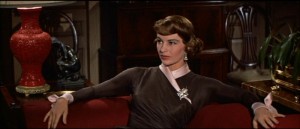 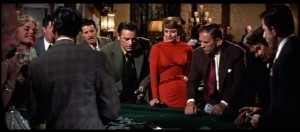 |
|
| 3) Traquenard (Party Girl, Nicholas Ray 1958). This movie was a cause celèbre at Cahiers du Cinéma in 1960, during that magazine’s golden age. A gorgeous period gangster film with a Chicago setting —- the last stateside studio film that Ray would direct, filmed in CinemaScope, and the only film he ever made for glitzy MGM — it was reviled in most of the French press at the same time that it was being passionately and polemically defended by one of its more extreme critics at the time, who later became a distinguished diplomat, the Iranian-born Fereydoun Hoveyda. Throwing down the gauntlet, he wrote, “Party Girl has an idiotic story. So what? If the substratum of cinematic work was made up simply of plot convolutions unraveling on the screen, then we could just annex the Seventh Art to literature, be content with illustrating novels and short stories (which is precisely what happens to a great many films we do not admire), and hand over Cahiers to literary critics.” But in fact, I regard this movie’s story as far from idiotic. Basically a tragic and touching love story between a showgirl who dances and a crooked lawyer who’s crippled, it costars two of the most wooden actors in 50s Hollywood, Cyd Charisse and Robert Taylor, and Ray manages to get extremely touching and vulnerable performances out of both of them (as well as from costars Lee J. Cobb, John Ireland, and Kent Smith). Unlike the next item on this list, another French PAL release, there are no extras of any kind on this release, so I’m honoring it simply for the sumptuous pleasure afforded by the film’s sounds and images. (A close runner-up —- the Masters of Cinema’s splendid edition of Ray’s The Savage Innocents —- has many wonderful extras.) | |
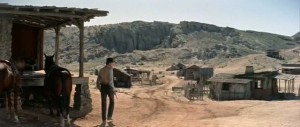 |
|
| 4) L’Homme de l’ouest (Man of the West, Anthony Mann, 1958). My favorite Anthony Mann Western in CinemaScope — intricately plotted and scripted by one of the best writers of TV dramas, Reginald Rose, adapting a Will C. Brown novel — gets a superbly letterboxed mounting on this French DVD, which is reason enough to recommend this 2004 release. It’s true that all three of the extras —- a 13-minute documentary about Mann, a 13-minute recitation and illustration of Jean-Luc Godard’s 1959 review of the film, and a 21-minute feature in which Mann enthusiasts Pierre Rissient and Bertrand Tavernier discuss the film, all directed by Nicolas Ripoche —- lack any subtitles, and the only clips they use come from Man of the West, so they have to depend on stills and still photographs for everything else. But even if you don’t speak French, these extras offer a fine introduction to the depth and enthusiasm of a certain kind of French criticism about American auteurist cinema. So part of the discussions of Rissient (aptly if strangely identified as a “chausseur des cinéastes,” which literally means a “hunter of filmmakers”) about Mann’s uses of landscape and a theatrical mise en scène and Tavernier (“cinéaste”) about Gary Cooper’s performance may elude you. (One interesting topic that both commentators touch on relates to the fact that Lee J. Cobb, the main villain, who plays a father figure to Cooper’s hero, was actually a full decade younger than Cooper.) But you can easily hunt down Godard’s brilliant essay “Supermann” (one of his best) in English in his book Godard on Godard and use it like a libretto to follow the second bonus mentioned above. |
Compared by DVDBeaver HERE Available for purchase from Amazon.FR HERE |
Rissient also has some pertinent observations about Mann’s background in theater. From the more recent and excellent Criterion DVD of The Furies, I learned that Mann attended a good many outdoor amphitheater productions of Greek tragedies as a child, and the way he uses his spectacular landscapes as well as violence in Man of the West strongly reflects this influence. It’s also worth noting that Mann’s special flair for off-center framing, which often reminds me of the compositions of Michelangelo Antonioni (a near-contemporary), meshes perfectly with both his talent as a landscape artist and his theatrical training.
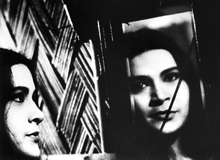 |
|
| 5) Meghe Dhaka Tara (The Cloud-Capped Star, 1960). Ritwik Ghatak, 1960). It wouldn’t be an exaggeration to call the maverick Bengali filmmaker Ritwik Ghatak (1925-1976) one of the most neglected major filmmakers in the world—-for starters, none of his films has ever been distributed in the U.S.–though given the extreme overall disorder of his life and career, this probably shouldn’t be too surprising. Fortunately, one of his masterpieces—-arguably, along with his earlier feature Ajantrik (Pathetic Fallacy, 1958), his greatest work–is available on DVD from the British Film Institute in a fine edition.
Reviewed by DVDBeaver HERE Available for purchase from Amazon.UK HERE |
|
This tragic two-hour melodrama follows the struggles of a poor refugee family in Calcutta. Beautifully shot in black-and-white, deep-focus photography, The Cloud-Capped Star often reminds me of Orson Welles’ The Magnificent Ambersons, despite the striking difference in the class being depicted, as another tragic portrayal of the shifting fortunes of a family set against a larger backdrop of a culture in relentless decline, with a great deal of emphasis placed on the sacrifices made by some of the family members, in particular the oldest daughter. No less Wellesian is the way Ghatak’s prodigious soundtrack–often layered between music, dialogue, and sound effects that can be naturalistic (such as the sound of food cooking on a grill) or expressionistic (such as the recurring sound of a cracked whip) — is composed in a kind of counterpoint to its images. In his otherwise sensitive introduction, English critic Derek Malcolm misleadingly speaks of the film’s innovative use of “natural sound,” but it’s important to stress that post-dubbing is as central to Ghatak as it is to Welles — or to Jacques Tati, for that matter. All three filmmakers might be said to compose each of their films twice —- once while shooting and then a second time while recording their soundtracks. And Ghatak is in some ways the most radical of the three in the degree to which his soundtracks “revise” his images. Much as our visual attention shifts in some shots from foreground to background and back again because of the construction of the layered images, our aural attention shifts at times between music, dialogue, and sound effects, which in turn affects the direction of our gaze in relation to those images.
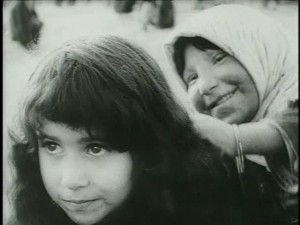 |
|
6) Un feu (Ebrahim Golestan, 1961) & La maison est noire (Forough Farrokhzad, 1962). Two Iranian documentary shorts, A Fire and The House is Black — the second of which can be described as the greatest (and in some ways, the most influential) of all Iranian films. The latter —- written, directed, edited, and largely narrated by the great Forough Farrokhzad (1935-1967), a mythical figure in Iranian culture who’s widely regarded as both the greatest Persian poet of the 20th century and the greatest of all Iranian women poets —- is a 22-minute documentary about a leper colony outside Tabriz, the capital of Azerbaijan, and is the greatest fusion of cinema and poetry that I know. It’s the only significant film Farrokhzad (or Forugh, as Iranians prefer to call her) ever made. (For information about a recently published collection of her poetry in English translation, go HERE) The year before Forugh made it, she trained as a film editor working for her lover Ebrahim Golestan — one of the key filmmakers of the first Iranian New Wave and a notable short story writer who was the first one to translate such writers as Twain, Faulkner, and Hemingway into Persian—-and her most significant editing work was on A Fire. This is an account of a 1958 oil well fire near Ahvaz that lasted over two months until an American fire-fighting crew managed to extinguish it, and although it doesn’t represent Golestan’s filmmaking at its best, it’s none the less a striking piece of work.
 |
Available for purchase from Amazon.FR HERE |
During its six years of existence (2001-2007), the biannual magazine Cinéma was arguably the most irreplaceable as well as the most lavishly illustrated French journal of film history and film criticism, and it included a DVD featuring a major film restoration in each the last ten of its thirteen issues. (Other DVDs in the series featured rare short works by Jean Eustache, John Ford, Kenji Mizoguchi, Luc Moullet, and King Vidor, among others.) The House is Black (though not A Fire) is available with English subtitles in a nonrestored and slightly less complete version from Facets Video, but the French subtitled version included in Cinéma 07 is the best version of the film available anywhere. You can purchase it online HERE, and most of the subsequent issues with DVDs (Cinéma 08 through 014) at the same French Amazon site.
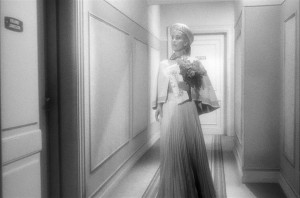 |
|
| 7) Gertrud (Carl Dreyer, 1965). As noted above, this is another masterpiece that can be acquired elsewhere in a restored edition with English subtitles. But only the Australian edition on the Madman label has Adrian Martin’s excellent critical commentary — not to mention the option of watching the subtitles in either white or yellow lettering. Martin starts off with an unfortunate howler when he notes in passing that Gertrud premiered in Cannes rather than at the Venice film festival, but virtually everything that follows is just and insightful. As one of the best-read film critics we have, he’s especially helpful in the way he discusses the work of others about the film —- David Bordwell, Maurice Drouzy, Frieda Grafe, Jacques Rivette, myself, André Téchiné, even a Scandinavian scholar I’d never heard of before, Morten Egholm, whose valuable essay Martin found on the Internet. (You can find it HERE). And he’s equally adroit in charting some of the fascinating multiple implications of the tendency of the film’s actors to avoid eye contact with one another. (This Australian edition also includes Dreyer’s most memorable short, They Caught the Ferry, a creepy, cautionary road-safety narrative from 1948 -— like all the other Dreyer shorts, a government commission, and interview outtakes from Torben Skødt Jensen’s 1995 documentary Carl Th. Dreyer: Mon Métier. | |
Gertrud, Dreyer’s last feature, continues to be his most controversial, almost half a century after his death. A slowly paced but intensely lyrical and uncannily lit adaptation of a 1906 Swedish play by Hjalmar Söderberg about love and passion and their consequences, it focuses on the heartbreak of its intransigent title heroine (Nina Pens Rode), a former opera singer married to a prominent politician (Bendt Rothe), who abruptly leaves him for a much younger composer (Baard Owe). The latter winds up disappointing her as well, but she also refuses to go back to a former lover, a famous poet (Ebbe Rode), preferring to grow old in solitude. (Owe and Axel Strøbye, who plays her best friend, are the two actors interviewed in the documentary outtakes.) A tragic yet wistful testament by Dreyer (who once called film his “only passion”) to his own lifelong intransigence, it represents his art at its most concentrated, exquisite, and deeply felt.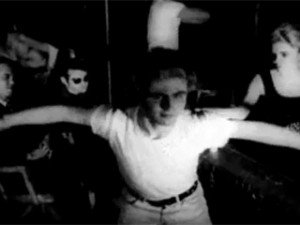 |
|
| 8) Vinyl (Andy Warhol, 1965) & The Velvet Underground & Nico (Andy Warhol 1966). So far I’ve only sampled the second of the two black and white films on this Italian release (on the Rarovideo label), 67 minutes long — a performance shot by Paul Morrissey which has often been cited, praised, and discussed by ace French critic Nicole Brenez, and which features Warhol superstar Nico with her young child as well as Warhol’s house band. But as with some of the shorts on Their First Films (see above), seeing it all is something I’m looking forward to. And Vinyl, which is only about a minute shorter, was made the year before, and suggests some parallels to the other film in its handling of space, is my favorite among all the Andy Warhol films I have seen. In this particular version, you can see it either in English (with or without Italian subtitles) or dubbed into Italian; the music film needs no translation. This package comes with a helpful 68-page critical book in Italian and English. |
Available for purchase from Amazon.com HERE |
Six years before the release of Stanley Kubrick’s A Clockwork Orange, Warhol paid $3,000 for the rights to Anthony Burgess’s source novel before making this very, very loose adaptation, scripted by Ronald Tavel —- so loose that most viewers of the film won’t recognize any resemblance, much less fidelity, apart from the periodic appearance of various beatings and other S&M rituals, all of which have been rendered as somewhat ridiculous, absurdist, and affectless by the way they’re staged. Even the hero, named Axel in the original, has been renamed Victor, for no apparent reason. Shot in direct sound with music by the Velvet Underground as well as appearances by such Warhol regulars as Gerard Malanga (performing a whip dance, frugging, and beating up at least one so-called “intellectual”), Ondine, and Edie Sedgwick, Vinyl is one of the most painterly and intricately composed of Warhol’s films. Most of it’s shot from the same camera angle, suggesting a kind of stasis in spite of the frenetic activities being shown that’s broken only by a few backward or forward zooms and deploying space that’s so crowded with seemingly autonomous (or at least mutually alienated) activities, sometimes as many as four or five at once, that it periodically suggests a classical painting depicting royalty or aristocracy — albeit one whose various inhabitants are all paradoxically squeezed into one fairly small room. 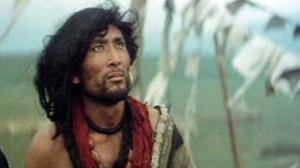 |
|
|
Available for purchase from Amazon.com HERE |
9) The Horse Thief (Tian Zhuangzhuang, 1986). When he made this bold CinemaScope feature with a Tibetan setting 20-odd years ago, the director —- for me, the best and most important of all the “fifth generation” Chinese filmmakers who entered the Beijing Film Academy after the end of the Cultural Revolution and began to have access to a wide range of films from abroad — said he’d made it for the 21st century. The plot concerns an occasional horse thief who is eventually expelled from his clan for stealing temple offerings, and part of what Tian must have had in mind is that because of its Tibetan subject and possibly its style as well, the film hardly showed in mainland China at all; only 11 prints were made (in contrast to the 200 to 300 prints made of most Chinese features at the time), and even before it was released, it suffered two kinds of censorship. One of these was an addition rather than a subtraction––the date “1923,” which flashes on the screen before the first image, thus locating the action in a specific period rather than making it more timeless, which was the director’s intention. The other form was the elimination of corpses from the first of three separate “sky burials” in the film, when human bodies are fed to carrion birds. We do in fact see these birds feeding on flesh –- they appear at the beginning of the film, in the middle, and again at the end –– but evidently the original version was more explicit. |
The most versatile, unpredictable, and iconoclastic of the major Chinese filmmakers, Tian has subsequently directed such features as The Blue Kite (1993), Springtime in a Small Town (2002), and The Go Master (2004), all of which have been much more widely shown, as well as the gorgeous 2004 documentary Delamu (about a spectacular Tibetan trade route, and named after a particular donkey) that has been seen and shown even less than The Horse Thief. For me, Tian is, along with Jia Zhangke, China’s greatest living filmmaker, and The Horse Thief shows you why. 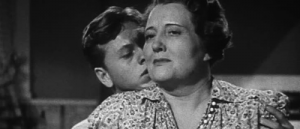 |
|
| 10) Martin Arnold: The Cineseizure (Pièce touchée, 1989; Passage à l’acte (1993), Alone. Life Wastes Andy Hardy (1998), & four “bonustracks” (1993-1997). When it comes to horror, I’m not much of a fan of slasher films, which seems to have dominated the genre ever since Psycho; for me, the genre is virtually restricted to three other masterpieces — M, The Leopard Man, and Peeping Tom. In terms of sheer horror and terror, I prefer in some respects The Cineseizure of Martin Arnold, an Austrian experimental filmmaker who manipulates fragments of black-and-white Hollywood features through optical printing and editing, and has an uncanny aptitude for turning Hollywood domestic dreams into the most unsettling nightmares imaginable. A hardcore structural filmmaker working with diabolical repetitions of both image and sound, he can actually be seen on one of the four “bonustracks” of this DVD, a trailer made for a film festival called the Viennale, expanding a single point-of-view shot of the shower in Psycho —- just the shower nozzle, nothing else, with and without water pouring down from it — to 48 seconds, scaring me almost as much as Hitchcock did over an entire feature. |
Pièce touchée, working with a fragment from Joseph M. Newman’s 1954 police procedural The Human Jungle for 16 minutes, shows a woman reading in a chair as a door behind her repeatedly opens and closes; a man finally enters and engages in some kind of interaction with her, and Arnold essentially turns the two figures into epileptic dolls with his relentless repetitions and reversals. For 12 minutes, Passage à l’acte takes a few short fragments of a scene from To Kill a Mockingbird, with a father (Gregory Peck) and mother figure, little girl, and little boy sitting at the breakfast table, and loops, inverts, and scrambles them to an even more bizarre effect. But the real unsettler here is the 15-minute Alone. Life Wastes Andy Hardy, which takes various bits from three separate Andy Hardy comedies starring Mickey Rooney, Judy Garland, and others and manages to yield mother-and-son incest, insanity, grief, and death out of them. In Arnold’s archetypal Hollywood small town, lovers kiss repeatedly in a park, then start hissing and emitting ducklike wheezes like geeks. This is a blighted cosmos where Judy sings “alone” first like a melancholy foghorn and then as if someone has just stepped on her foot –- and where a door repeatedly opens and closes as if attacked by some poltergeist until Mickey finally enters in a top hat and tails and gets stuck in a perpetual dance shuffle, caught in an endless loop that makes us realize he’s actually in hell.
Reviewed by DVDBeaver HERE Available for purchase from Amazon.FR HERE |
11) Casa de Lava (Pedro Costa, 1994). I wouldn’t call this Costa’s greatest film; it precedes the radically new and different manner of filmmaking that he discovered with In Vanda’s Room (2000) and subsequently refined and extended in Colossal Youth (2004), with many of the same characters and settings. But this second feature of his is the one that affords me the most pleasure, for many reasons. It’s his only landscape film, and the landscapes themselves, on one of the Cape Verde islands, are quite spectacular. (When I recently expressed to Costa my desire that he make another landscape film, he responded with the succinctness of a Zen master: “It’s too easy.”) It’s a remake (of sorts) of Jacques Tourneur’s I Walked with a Zombie (1943), with some of the same lush spookiness and guilt about colonialist exploitation, with a comparable set of irrational narrative continuities and rational narrative discontinuities to go with its hypnotic rhythms and seductive visual patterns. Like all of Costa’s work, it rethinks and reformulates the glories of big-screen Hollywood in terms that are both intimately personal and deeply mysterious, mixing fiction and documentary to the point where they often become indistinguishable. |
The Portuguese and French editions of this DVD are virtually identical. Both have optional English, French, and Portuguese subtitles and the same exemplary extras, many of which emphasize the film’s intricate relations to other arts: a trip through Pedro Costa’s “notebook” while working on the film (actually, a fascinating scrapbook of texts and images), accompanied by original music by Raúl Andrade; an interview with French cinematographer Emmanuel Machuel (who has also shot several films by Manoel De Oliveira) that emphasizes his and Costa’s shared musical references while establishing the rhythm of scenes; excellent offscreen commentaries on selected scenes by French critic Serge Kaganski; and trailers for Casa de Lava as well as the Costa films that preceded and followed it, O Sangue (Blood) and Ossos (Bones).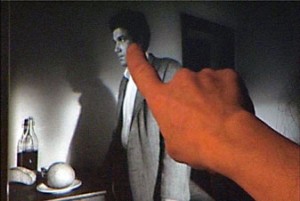 |
|
| 12) Onde Jaz O Teu Sorriso? (Where Does Your Hidden Smile Lie?, Pedro Costa and Thierry Loumas, 2001). What, Pedro Costa again? Yes, but both the film and the DVD in this case are quite different, though no less impressive. The DVD is boxed with a book in Portuguese containing the film’s dialogue and four other texts, and the film is a remarkable documentary made for French television, codirected by Thierry Lounas, about the filmmaking couple Jean-Marie Straub and the late Danièle Huillet editing one of the versions of their black and white feature Sicilia! (Many of their late features are edited in separate versions out of different takes.) Like Costa himself, this quarrelsome, loving, eccentric couple are avant-gardists with an unusually keen understanding of so-called classical cinema (Chaplin, Ford, Hawks, Mizoguchi, Ozu), and this becomes highlighted in Straub’s wonderful, cantankerous monologues, Huillet’s precise cuts (which we observe in detail while she and Straub are arguing over them), and Costa’s beautiful way of capturing them both. Australian film critic Adrian Martin calls this “probably the best documentary of any kind I have ever seen”; it’s certainly the best film ever made about editing. It feels very intimate, though Straub and Huillet at work were also being observed by students at the time (whose presence is elided by Costa — making this as much of a netherworld between fiction and documentary as Casa de Lava). | |
| As with the Iranian shorts included with Cinéma 07 (see above), this Portuguese item isn’t available from DVD outlets but only from certain book merchants. (Three online Portuguese sources: HERE, HERE and HERE; the latter is the website of the publisher, Assírio & Alvim.) In this case, there are optional English, Italian, and Portuguese subtitles, two separate versions of the film (the version shown on French TV and a longer, preferred Costa cut), six fabulous outtakes, and two unreleased short films by Huillet and Straub derived from scenes in the third version of Sicilia! The only thing missing, in fact, is the full version of Sicilia! that Straub-Huillet are seen editing. One full version is available on a separate Portuguese DVD, but I don’t know if it’s the same one, and, alas, this DVD apparently doesn’t have English titles. But you can’t have everything. | |

